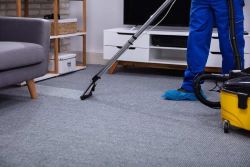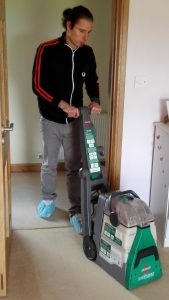 Dirty carpets are a good thing. Your rooms won’t look its best with stained and worn carpets. You need to employ a professional to help keep your carpets clean.What do you need from a carpet cleaning company if you want the job done right? The following advice will help you do just that.There are many companies available and some are reliable. Ask for their references from trusted individuals and check online as well. This is a good way to put together a list of reliable businesses in your needs.Vacuum your carpet before having it cleaned. Make use of a good vacuum cleaner in order to eradicate lose dirt by vacuuming prior to having your carpets cleaned. Your results won’t be great if there is a carpet that’s full of loose dirt laying around.Don’t use too much heat when cleaning your carpets. Heat can affect your carpet’s quality, particularly when delicate materials or elaborate patterns are involved. This is really important when trying to get rid of a stain out.Carpet cleaning companies also usually offer a number of services. A lot of times they will offer upholstery cleaning, so ask about it if you need that service. You might even find somewhere running a carpet/upholstery special.Remember that carpet cleaning agents often contain chemicals that could harm you or your family. Always read any labels on a cleaning product before using it, so you can be sure to get the best service.A quality carpet cleaner will give you a guarantee on their work. If you need to use the guarantee, give the company a second chance to fix the work. Ask for a refund if you are still aren’t satisfactory.You should have no problem finding a qualified professional with the information in this article. Take what you have learned here and soon, you will find that the process is simpler than you thought possible. A professional cleaning service can refresh your carpets. You’ll give your home a whole new fresh and clean look.
Dirty carpets are a good thing. Your rooms won’t look its best with stained and worn carpets. You need to employ a professional to help keep your carpets clean.What do you need from a carpet cleaning company if you want the job done right? The following advice will help you do just that.There are many companies available and some are reliable. Ask for their references from trusted individuals and check online as well. This is a good way to put together a list of reliable businesses in your needs.Vacuum your carpet before having it cleaned. Make use of a good vacuum cleaner in order to eradicate lose dirt by vacuuming prior to having your carpets cleaned. Your results won’t be great if there is a carpet that’s full of loose dirt laying around.Don’t use too much heat when cleaning your carpets. Heat can affect your carpet’s quality, particularly when delicate materials or elaborate patterns are involved. This is really important when trying to get rid of a stain out.Carpet cleaning companies also usually offer a number of services. A lot of times they will offer upholstery cleaning, so ask about it if you need that service. You might even find somewhere running a carpet/upholstery special.Remember that carpet cleaning agents often contain chemicals that could harm you or your family. Always read any labels on a cleaning product before using it, so you can be sure to get the best service.A quality carpet cleaner will give you a guarantee on their work. If you need to use the guarantee, give the company a second chance to fix the work. Ask for a refund if you are still aren’t satisfactory.You should have no problem finding a qualified professional with the information in this article. Take what you have learned here and soon, you will find that the process is simpler than you thought possible. A professional cleaning service can refresh your carpets. You’ll give your home a whole new fresh and clean look.
When you notice this problem, you’ll probably try to locate a company that can help you to get your carpets cleaned. Read this article to learn more about carpet cleaner.Test any solution on a corner of carpet not easily viewed. This is important to do because there are acids in some cleaners that may damage a rug permanently. This small investment of time can save you from making a very costly mistake.Not all carpets can be cleaned by carpet are suited to heavy duty cleaning machines and harsh chemicals. Silk and wool carpets can be damaged during the cleaning process. If you don’t know how to go about cleaning your carpet, consider hiring a professional.Wash all new carpets as soon as you buy the moment it’s in your home. Some carpets possess chemicals to help preserve their quality in tact.Make sure you know what your warranty is on your carpet. You can void your warranty if you apply a different stain treatment to some types of carpet.The chemicals may not mix well and cost you a bundle.
You need to feel at ease with any company you pay to help clean your carpet cleaning company. You need to be satisfied with the services you receive. A good company that cares will always put their customer’s needs first.
White vinegar is an effective cleaning solution. Even though the vinegar usually does an adequate job, to make sure you don’t ruin your carpeting, hire a professional to do the cleaning. Test this out on a part of your carpet to see if it’s safe before use.As stated at the beginning of this article, you are probably aware of how dirty your carpet can get. One thing you might not have thought of is what kinds of things you need to look at when selecting a company that cleans carpets. The article you’ve just read has given you great ideas you should keep in mind. Start using these tips to find a great carpet cleaning service.
Act immediately, if contaminating fluid spills onto the carpet, absorb the fluid thoroughly by a soft towel or white absorber paper, such as paper towel. Do not twist the material used for absorption, push it with your full weight instead, until it becomes full, then replace it again. Continue this process until the absorber does not become wet again when pressing it onto the stain area. Do not forget, that if you remove ALL moisture, then 95% of the stain can be removed without using chemicals, and removal of the residuary becomes easy. Dried stains are very tough, or even impossible to remove. NEVER SCRUB OR SCOUR STAIN SURFACES!
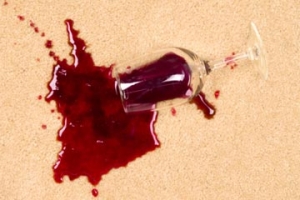
If a bigger among of fluid spilled onto the carpet, hoover the majority by a wet vacuum cleaner. Then the following absorption process may start.
Solid materials
Scratch the contamination with a knife of spatula, then hoover it, if no traces left. Remove the residual contamination according to the attached list.
Superficial contamination
It can be removed by effective hoovering. All residual particles continue their way to the bottom of the carpet, and they are very hard to remove. We recommend the use of standing vacuum cleaners designed for heavy duty, which are equipped with automatic brushes and mixer.
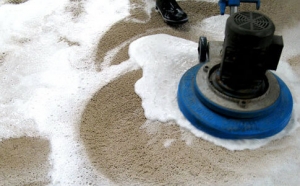
Suspended grease
Most superficial contamination partially contain fat or oil. The longer the contamination is in contact with fibers, the more grease reach the fluffes. Contamination not removed by the vacuum cleaner get between the fibers, and the fat or oil subsides onto the fibers, which enable them to attract even more contamination.
Downtrodden contamination
This is the combination of fat, oil and such heavier contaminations, like mud or sand.
When this contamination reaches the bottom of the carpet node, it usually remains there, until carpet cleaners perform a deep cleaning.
Wet contamination and stains
When a contamination becomes wet, it passes through the fibers faster, and they are tougher to remove. Wet stains spilled onto the carpet immediately pass through the fluffes, and deep cleaning process becomes necessary.
The following two main carpet abrasion dangers require to be dealt with in the most effective way:
Sand
This means the biggest danger on the lifetime of your carpet. Do not forget, that the biggest part of harmful sand is found between the fluffes. When sand is let between the fluffes, cutting edges on them quickly abrade the carpet, when people shuffle on it.
Water
Wet carpet, especially which contains sand, accelerate abrasion and decrease the carpet’s stability too. Please do your best to keep your carpet as dry as possible. When the carpet is wet, dry it as soon as possible by placing absorber paper on the wet area.
On the wet carpet, due to frequent steps, fluffy fibers of the carpet become quickly worn.
Contamination resistant carpet
Strategic placement of contamination resistant carpet significantly reduces the quantity of contamination and moisture brought to the carpet. It is crucial especially on areas next to the street, kitchen, bathrooms etc.
Because the contamination resistant carpet’s duty is to retain sand and moisture, it should be kept in good condition. It must be thoroughly hoovered every day, and cleaned with detergent every week if necessary. It is worth to consider the application of removable and washable protective carpet.
Do not forget, that if contamination resistant carpet is full with sand and dirt, then it will not remove the dirt from the shoes, but rather brings grease and dirt on the shoes instead of removing them. Thus it accelerates the contamination of adjacent carpet.
Choose such a contamination resistant carpet, that is maximal hygroscopic and easy-to-clean. The carpet type needs to be determined upon the consideration of what kind of contamination will be brought onto the carpet by people’s sole. Area to be covered by protective carpet shall be as large as possible, but at least two steps long, because people usually do not stop to clear their feet, when they enter into a room.
When the decoration of the place does not allow to apply protective carpet onto the area covered by carpet, then it is worth to think about applying protective carpet on the solid surface in front of the entrance.
Before purchasing a carpet, it must be determined first, which area is heavily used, where are possible contamination dangers, and these need to be treated so, that the carpet’s contamination shall decrease. Colour selection and contamination prevention treatments are very important factors for instance, and their application should be considered.
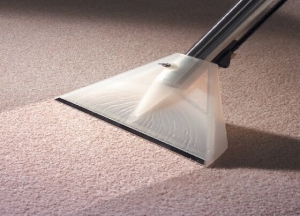
Maintenance shall be started right after the installation of the carpet. You should not let contamination to accumulate, causing spreading stains, because these quickly decrease the appearance of the carpet. You should not let contamination on the carpet for longer period, while it is impossible to remove later.
You have to work out a maintenance schedule in order to introduce and observe, what kind of cleaning/maintenance jobs, how often need to be performed.

The following duties are listed in a typical maintenance plan:
Those areas, that need to be hoovered daily
Those areas, that need to be hoovered on every second day
Those areas, that need to be hoovered on every third day
Those areas, that need to be hoovered once a week
Daily stain cleaning
Stain cleaning, when it becomes necessary
Monthly cleaning of high traffic areas
Quarter year cleaning of high traffic areas
Half year cleaning of medium traffic areas
+ Annual cleaning of low traffic areas
Areas cleaned if necessary (less used areas)
Introduction
While we think so, that the maintenance guide is very useful, it is extreme important, that the cleaner staff must be well-trained in report making and handling maintenance processes.
From this aspect, we consider the most important part of maintenance training, that there should be a system, where they can report stains and their removal, and to ensure that they keep all cleaning tools in good shape.
Decisions are made very often about deep cleaning of the carpet due to a localized stain, thus we recommend to always keep the required chemicals at hand to remove most common stains. We figured out, that use of stain removal kits is a very efficient method of bringing detergents to the area of contamination. We recommend to keep these kits in a central place. We can not emphasize enough the importance of the staff being well-trained in stain removal.
If you need further information, please do not hesitate to contact us!
The followings are valid for all types of stains:
After the emergence of the stain, solid materials need to be removed immediately using a spoon. Then a soft cloth immersed into warm water needs to be placed on it multiple times, in order to sponge up the contamination. Always use uncolored absorber, and move to the centre of the stain. If there is nothing to sponge up anymore, dry it with cold hairdryer level. If you do not manage to remove the stain, see our stain table. Always move from the side to the centre of the stain.
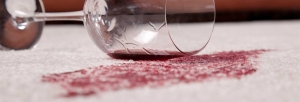
Methods
1. Let it dry, then hoover it.
2. Hoover it.
3. Hoover it, then treat it with clean, white cloth immersed into clean, warm water multiple times (rinse). Always use uncoloured absorber. In case of wool, do not scrub. Dry with the hairdryer’s cold level.
4. Treat it with clean, white cotton linen immersed into cold water. Always use uncoloured absorber. In case of wool, do not scrub. Dry with the hairdryer’s cold level.
5. Treat it with such a clean, white cloth, that you have immersed into a solution of 15 ml biological soaker, 15 ml vinegar and half litre of cold water multiple times. Then absorb it with cold water multiple times. Always use uncoloured absorber. In case of wool, do not scrub. Dry with the hairdryer’s cold level.
6. Treat it with such a clean, white cloth, that you have immersed into the solution of 15 ml mild soaker, 15 ml white vinegar and half litre of lukewarm water. Then absorb it with uncoloured absorber multiple times. In case of wool, do not scrub. Dry with the hairdryer’s cold level.
7. Treat with such a clean, white cotton cloth multiple times, that you have immersed into the solution of 15 ml biological soaker, 15 ml white vinegar and half litre of lukewarm water. Then absorb it with cold water multiple times. Always use uncoloured absorber. In case of wool, do not scrub. Dry with the hairdryer’s cold level.
8. Treat with such a clean, white cotton cloth, that you have immersed into the solution of 15 ml of mild detergent, 15 ml white vinegar, 5 ml lime juice and half litre of lukewarm water. Then absorb it with cold water and uncoloured absorber multiple times. In case of wool, do not scrub. Dry it with the hairdryer’s cold level.
9. Treat with clean, white cotton linen immersed into tetrachloroethylen multiple times. Then absorb it with cold water. Always use uncoloured absorber. Then treat with such a cotton cloth, that you have immersed into the solution of 15 ml mild detergent, 15 ml white vinegar and half litre of lukewarm water. Then absorb it with cold water and uncoloured absorber multiple times. In case of wool, do not scrub. Dry with the hairdryer’s cold level.
1O. Try to let it dry naturally, and remove it carefully. At the end, treat with such a clean, white cloth multiple times, that you have immersed into the solution of 15 ml biological soaker, 15 ml white vinegar, 5 ml lime juice and half litre of lukewarm water. Then absorb it with cold water and uncoloured absorber multiple times. In case of wool, do not scrub. Dry with the hairdryer’s cold level.
11. Treat with such a clean, white cotton cloth, that you have immersed into alcohol (found in the pharmacy) multiple times, then absorb with cold water and uncoloured absorber multiple times. Then treat with such a cloth multiple times, that you have immersed into the solution of 15 ml biologic soaker, 15 ml white vinegar and half litre of lukewarm water. Then absorb it with cold water multiple times. Then absorb it with cold water multiple times as described above. In case of wool, do not scrub. Dry with the hairdryer’s cold level.
12. First hoover it. Treat with clean, white cotton linen immersed into tetrachloroethylene. Then absorb it with such a clean, white cloth, that you have immersed into the solution of 15 ml mild detergent, 15 ml white vinegar and half litre of lukewarm water. Then absorb it with cold water multiple times. In case of wool, do not scrub. Dry with the hairdryer’s cold level.
13. Treat with clean, white cotton linen immersed into tetrachloroethylene. Then absorb it with white water multiple times. Always use uncoloured absorber. In case of wool, do not scrub.
14. Treat with clean, white cotton linen immersed into tetrachloroethylene. Then absorb it with cold water multiple times. Always use uncoloured absorber. Then absorb it with such a clean, white cotton linen, that you have immersed into the solution of 15 ml mild detergent, 15 ml white vinegar, 5 ml lime juice and half litre of lukewarm water. Then absorb it with cold water multiple times, as described above. In case of wool, do not scrub. Dry with the hairdryer’s cold level.
15. Cover with multiple layers of uncoloured textile, and iron with warm iron (the temperature depends on the material of the carpet fiber) until absorption finishes. Absorb it with cold water and uncoloured absorber. Then treat with such a clean cotton linen, that you have immersed into the solution of 13 ml vinegar and half litre of lukewarm water. Then absorb it with cold water multiple times, as described above. In case of wool, do not scrub. Dry it with the hairdryer’s cold level.
16. Cover with multiple layers of uncoloured textile, and iron with warm iron (it shall not be too hot, especially if there is cotton carpet) until absorption finishes.
17. Freeze with aerosol chewing gum remover, break it, brush, then hoover.
18. Treat with clean, white cotton linen, that you have immersed into acetone (it is flammable, so be careful with the fire).
Fluids
Immediately absorb the spilled fluid with a towel or paper. Do not twist the material used for absorption, push it with your full weight instead, and when it impregnates, replace it again. Repeat this process until the tucker does not become wet anymore. If you remove all moisture, then 95% of the stain can be removed without chemicals, and the removal of the residuary becomes easy. Already dried stains are hard, or even impossible to remove. Never scrub or scour the stain, the stain area!
If a bigger amount of fluid spilled out onto the carpet, mop up the most of the fluid with wet vacuum cleaner. Then the above described tucking process shall be started.
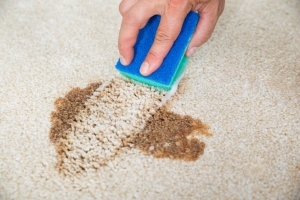
Solid materials
Scratch the contamination with a knife of spatula, then hoover it, if no traces left. Remove the residual contamination according to the attached list.
Powders
Hoover it thoroughly, in order to leave no powder between the fibers.
Stain removal kits
These tools, according to their contents, cover cosmetic materials as well as well-stored stocks, which require several preparations to remove stain. The materials shall have easy-to-understand user manuals.

Example of kit of items of the kit
1. White kitchen sponge-cloth to remove spilled fluids.
2. Stain remover to completely remove fresh fluid stains following wash-up, as well as elder stains.
3. Tuckers to apply stain remover.
4. A pack of dry cleaner powder.
5. A small brush to apply dry cleaner powder into carpet fluffes .
- Less educated cleaners prefer to use much water and detergent.
- Warm-water carpet cleaning is often considered as the tool of major cleaning, so they let the carpet become dirty, saying it can be cleaned by warm-water cleaning. Cleaners are often seduced to increase the concentration of detergent solution when cleaning very dirty areas.
- Cleaned carpet needs to be fully dried before stepping on them. Enterprises often perform this operation on Friday night or Saturday morning, supposing the carpet will be dried by Monday morning.
- A carpet seems to be dry, might be still wet depending on the humidity level.
- If the wet carpet is not let to completely dry, although it looks like cleaner at first glance, it will result up in getting a spectacular contamination soon (applied detergents attract contaminations and the wet carpets work similar to a duster: it removes and absorbs dirt from the shoes.) If sand gets into the wet carpet, abrasion significantly speeds up.
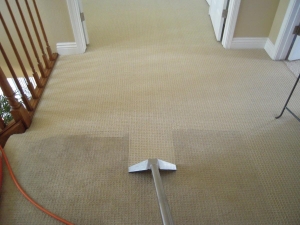
Warm-water cleaning is a good method for educated cleaners, this method can complement dry cleaning method.
Professional Carpet cleaning Cork
20 years experience. Call us Today for an appointment!
Professional carpet cleaning Cork.
Carpet and upholstery cleaning Cork
personal development
Vacuum Regularly: Regular vacuuming is essential to remove loose dirt, dust, and allergens from your carpets. Aim to vacuum at least once a week, or more frequently in high-traffic areas.
Address Stains Immediately: Promptly attend to spills and stains to prevent them from setting into the carpet fibers. Blot the stain with a clean cloth or paper towel to absorb as much liquid as possible before applying any cleaning solution.
Test Cleaning Products: Before using any cleaning product on your carpet, test it on a small, inconspicuous area to ensure it doesn't cause discoloration or damage. This step is particularly important for homemade cleaning solutions.
Use Baking Soda for Odor Removal: Baking soda is an excellent natural deodorizer. Sprinkle baking soda liberally over your carpets, leave it for a few hours (or overnight), and then vacuum thoroughly to remove odors.
Regularly Change Vacuum Bags and Filters: Clean or replace your vacuum bags and filters regularly to maintain optimal suction and prevent dirt from being released back into the air or settling back onto the carpet.
professional carpet cleaning
Hire Professional Cleaning: Periodically, consider hiring professional carpet cleaners to deep clean your carpets. They have specialized equipment and expertise to remove deep-seated dirt and stains, improving the overall appearance and longevity of your carpets.
Use Entrance Mats: Place entrance mats both outside and inside your home to reduce the amount of dirt and debris brought in from outside. This helps prevent excessive soiling of your carpets.
Remember, proper carpet maintenance involves a combination of regular cleaning, prompt stain removal, and occasional professional cleaning. By following these tips, you can keep your carpets looking clean and fresh for longer.
professional carpet cleaners in Cork
Professional carpet cleaners often achieve better results than DIY methods for several reasons:
Advanced Equipment: Professional carpet cleaners use high-grade cleaning machines and tools that are more powerful than the typical consumer-grade equipment available for rent or purchase. These machines can provide deeper cleans, extracting dirt, bacteria, and allergens more effectively from the carpet fibers.
Expertise and Experience: Professional cleaners have the training and experience to handle various types of carpets and stains. They know the best techniques and products to use for different situations, ensuring that carpets are cleaned effectively without causing damage.
High-Quality Cleaning Solutions: Professionals have access to commercial cleaning solutions that may not be available to the general public. These solutions are often more effective at removing stains and odors.
Upholsterycleaning.ie
Cork and Kinsale
Co.Cork
Ireland
089 7064540
[email protected]
Cleaning a couch at home depends on the type of fabric or upholstery used. Here is a general guideline for cleaning a couch, but please note that it’s always a good idea to check the manufacturer’s instructions or tags for specific cleaning recommendations:
Vacuum the Couch: Begin by thoroughly vacuuming the couch to remove loose dirt, dust, and debris. Use a brush attachment to reach into crevices and between cushions.
Check for Stains: Identify any stains or spots on the couch. It’s important to treat stains promptly to increase the chances of successful removal.
Read the Care Labels: Check for care labels attached to the couch or consult the manufacturer’s instructions for cleaning guidance. These labels typically provide information on suitable cleaning methods and any recommended cleaning products.
Spot Cleaning: For small stains or spills, you can spot clean the affected area. Test any cleaning solution on a small, inconspicuous area of the couch first to ensure it doesn’t cause discoloration or damage.
a. Blot the stain with a clean, white cloth or paper towel to absorb as much of the spill as possible.
b. Depending on the type of stain, you can use a mild detergent mixed with water, a specialized upholstery cleaner, or a homemade solution like a mixture of mild dish soap and water. Apply a small amount of the solution to the stain and gently blot with a clean cloth. Avoid scrubbing, as it may push the stain deeper into the fabric or spread it.
Full Cleaning: If your couch requires a thorough cleaning, you can use a steam cleaner or hire a professional upholstery cleaning service. Steam cleaners can help remove dirt and bacteria from the fabric. Follow the manufacturer’s instructions for operating the steam cleaner and take care not to oversaturate the fabric.
Drying: After spot cleaning or steam cleaning, allow the couch to dry completely before using it. Open windows or use fans to aid in the drying process and prevent any potential mildew or mold growth.
It’s worth noting that some couches may have specific cleaning requirements or may be made of delicate fabrics that require professional cleaning. In such cases, it’s best to consult a professional upholstery cleaner for advice or assistance.
- Efficiency: Because they are equipped with better tools and products, professional cleaners can complete the job more quickly and efficiently, saving time and potentially preventing further damage to the carpet that can occur with prolonged dirt and stain exposure.
- Improved Air Quality: Professionals can remove more dust, allergens, and bacteria from carpets than DIY methods, improving the air quality inside your home.
- Longevity of Carpet: Regular, professional cleaning can extend the life of your carpet by removing debris that can degrade the carpet fibers over time.
- Guarantee: Many professional carpet cleaning services offer a satisfaction guarantee, ensuring that if you are not happy with the results, they will address the issues at no additional cost.
Service Hours
Mon-Fri: 8:00-20:00
Sat: 8:00-14:00
Upholstery Cleaning Advice
While cleaning upholstery yourself can be effective, there are situations where it’s best to call a professional upholstery cleaner.You can also find great upholstery cleaning advice here:
The best carpet cleaning service provider can vary depending on various factors such as location, specific needs, and individual preferences. However, there are a few common factors to consider when choosing a carpet cleaning service provider:
Reputation: Look for a provider with a good reputation and positive customer reviews. You can check online review platforms or ask for recommendations from friends, family, or neighbors.
Experience and Expertise: Consider the experience and expertise of the service provider. Find out how long they have been in business and whether they have specialized in carpet cleaning.
Services Offered: Different providers may offer different services, such as steam cleaning, dry cleaning, or eco-friendly options. Choose a provider that offers the specific services you require.
Certifications and Licenses: Check if the carpet cleaning service provider has proper certifications and licenses. These can be an indication of their professionalism and adherence to industry standards.
Insurance Coverage: Ensure that the provider has liability insurance to cover any potential damages that may occur during the cleaning process.
Pricing: Compare the pricing of different service providers and consider the value for money they offer. However, be cautious of overly cheap services, as they may not always deliver satisfactory results.
Customer Service: Pay attention to the level of customer service provided by the company. A reliable provider should be responsive, professional, and able to address any concerns or queries you may have.
It’s recommended to research and contact multiple carpet cleaning service providers in your area to get quotes, ask questions, and make an informed decision based on your specific needs.
While DIY carpet cleaning can be effective for small stains or regular maintenance, professional carpet cleaning services offer a level of thoroughness and care that is difficult to achieve on your own. This is especially true for high-traffic areas, stubborn stains, or if the carpet is in need of a deep clean.
- Professional – Indicates a high level of expertise and formal training in carpet cleaning.
- Experienced – Shows that the service has been in the business for a significant period and has a solid track record.
- Eco-Friendly – Suggests the use of environmentally safe cleaning products and practices.
- Advanced Equipment – Implies the use of the latest technology and machinery for deep cleaning.
- Satisfaction Guarantee – Offers assurance of the service’s commitment to meeting client expectations.
- Certified Technicians – Indicates that the staff has received professional certification and training.
- Affordable – Suggests that the service provides good value for the price.
- Quick Drying – Points to efficient methods that allow carpets to dry faster after cleaning.
- Free Estimates – The willingness to provide a cost estimate without charge, reflecting transparency and customer service.
- Allergen Reduction – Indicates a focus on removing allergens to improve indoor air quality.
- Stain Removal Expertise – Specialization in removing tough stains, which is a key concern for many customers.
- Flexible Scheduling – Shows that the service is willing to work around the customer’s schedule.
- Pet Safe – Ensures that the cleaning methods and products are safe for pets.
- Odor Removal – The ability to effectively remove unpleasant odors from carpets.
- Customer Reviews/Ratings – Positive feedback from previous customers, indicating satisfaction with the service.
- Insured and Bonded – Provides peace of mind that the company is covered in case of damages or accidents.
- 24/7 Emergency Services – Availability for unexpected needs or immediate cleaning situations.
- Attention to Detail – Suggests thoroughness in cleaning every part of the carpet, including edges and hard-to-reach areas.

